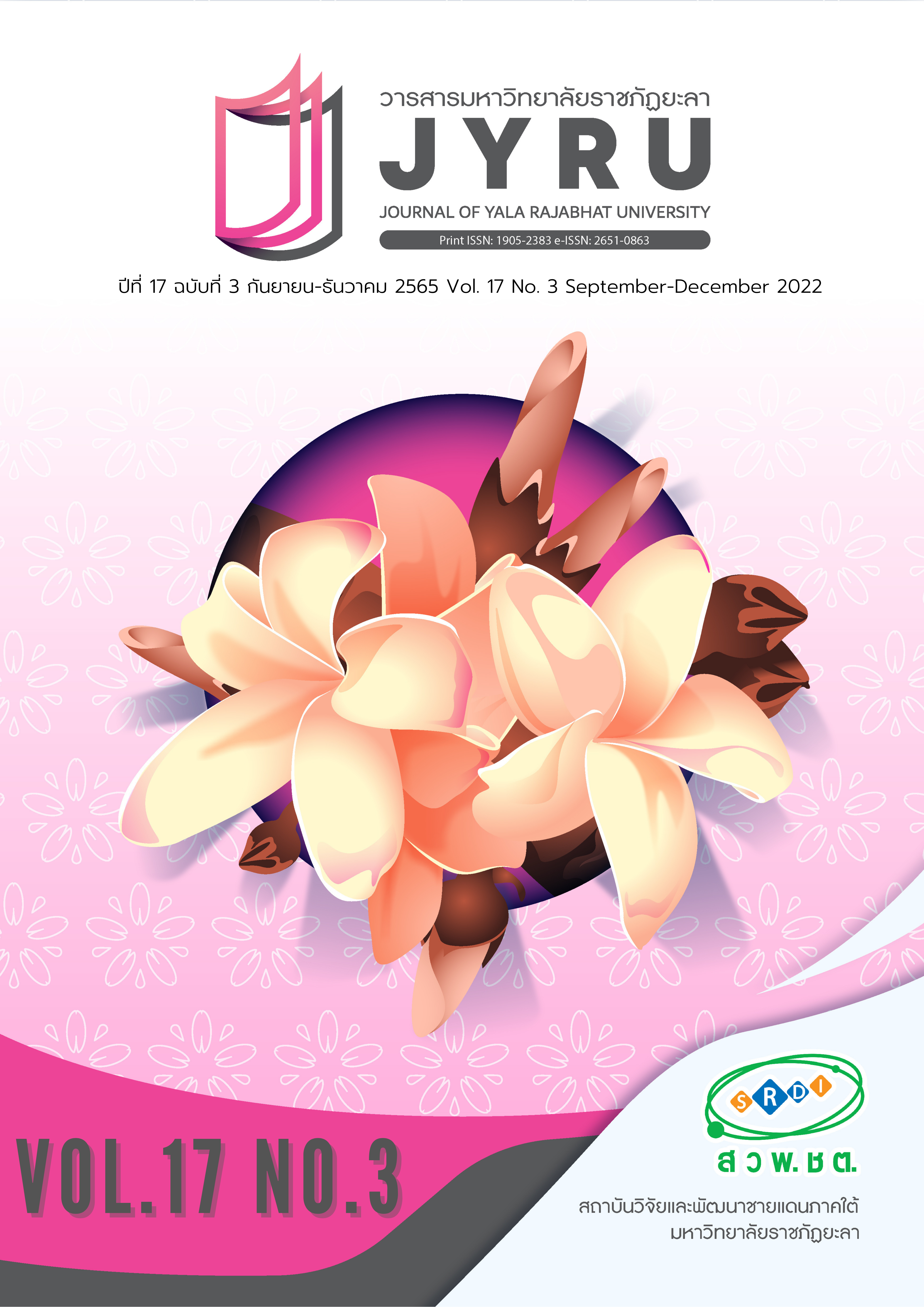โมเดลเชิงสาเหตุของการรับรู้กลิ่น การตลาดเชิงประสบการณ์ พฤติกรรมการตอบรับที่ส่งผล ต่อความตั้งใจใช้บริการซ้ำของผู้บริโภคที่ใช้บริการสปาในเขตกรุงเทพมหานคร
Main Article Content
บทคัดย่อ
สภาพการแข่งขันที่รุนแรงขึ้นของธุรกิจสปาในประเทศไทย การนำกลยุทธ์การตลาดเชิงประสบการณ์โดยใช้กลิ่นเป็นสิ่งเร้า สร้างความแตกต่างและสร้างประสบการณ์ที่น่าประทับใจส่งผลให้ผู้บริโภคตั้งใจใช้บริการซ้ำ จึงวิจัยโดยมีวัตถุประสงค์เพื่อทดสอบความสอคคล้องของโมเดลเชิงสาเหตุและศึกษาอิทธิพลของการรับรู้กลิ่น การตลาดเชิงประสบการณ์ และพฤติกรรมการตอบรับที่ส่งผลต่อความตั้งใจใช้บริการซ้ำของผู้บริโภคที่ใช้บริการสปาในเขตกรุงเทพมหานคร กลุ่มตัวอย่างที่ใช้ในการวิจัยครั้งนี้โดยวิธีสุ่มอย่างง่าย คือ ผู้บริโภคที่เคยใช้บริการสปาในเขตกรุงเทพมหานคร จำนวน 500 คน เครื่องมือที่ใช้ในการเก็บรวบรวมข้อมูล คือ แบบสอบถามและวิเคราะห์ข้อมูลด้วยการวิเคราะห์โมเดลสมการโครงสร้าง ผลการวิจัยพบว่า โมเดลดังกล่าวมีความสอดคล้องกับข้อมูลเชิงประจักษ์ โดยมีค่า 2 = 46.89, df= 36,
2 /df = 1.30, p-value = 0.11, GFI = 0.99, AGFI = 0.96, RMR = 0.020, RMSEA =0.03 อิทธิพลของการรับรู้กลิ่น การตลาดเชิงประสบการณ์ พฤติกรรมการตอบรับของผู้บริโภคต่อความตั้งใจใช้บริการซ้ำ ณ นัยสำคัญทางสถิติที่ระดับ .01 พบว่า การรับรู้กลิ่นมีอิทธิพลทางตรงต่อความตั้งใจใช้บริการซ้ำและมีอิทธิพลทางอ้อมผ่านการตลาดเชิงประสบการณ์และพฤติกรรมการตอบรับของผู้บริโภค การตลาดเชิงประสบการณ์มีอิทธิพลทางตรงต่อความตั้งใจใช้บริการซ้ำและมีอิทธิพลทางอ้อมผ่านพฤติกรรมการตอบรับของผู้บริโภค และพฤติกรรมการตอบรับของผู้บริโภคมีอิทธิพลทางตรงต่อความตั้งใจใช้บริการซ้ำของผู้บริโภค ดังนั้น ผู้ประกอบธุรกิจสปานำการใช้กลิ่น การนำสิ่งเร้าอื่น ๆ และการตลาดเชิงประสบการณ์มาใช้เพื่อให้เกิดพฤติกรรมการตอบรับของผู้บริโภคและทำให้ให้ผู้บริโภคกลับมาใช้บริการ
Article Details

อนุญาตภายใต้เงื่อนไข Creative Commons Attribution-NonCommercial-NoDerivatives 4.0 International License.
บทความ ข้อมูล เนื้อหา รูปภาพ ฯลฯ ที่ได้รับการเผยแพร่ในวารสารมหาวิทยาลัยราชภัฏยะลานี้ ถือเป็นลิขสิทธิ์ของวารสารมหาวิทยาลัยราชภัฏยะลา หากบุคคลหรือหน่วยงานใดต้องการนำทั้งหมดหรือส่วนหนึ่งส่วนใดไปเผยแพร่ต่อหรือกระทำการใดๆ จะต้องได้รับอนุญาตเป็นลายลักษณ์อักษรจากวารสารมหาวิทยาลัยราชภัฏยะลาก่อนเท่านั้น
เอกสารอ้างอิง
Eisinga, R., Te Grotenhuis, M., & Pelze, B. (2012). The reliability of a two-item scale: Pearson, Cronbach or Spearman-Brown? International Journal of Public Health, 58(4), 637-642.
Hair, J. F., Black, W. C., Babin, B. J., & Anderson, R. E. (2010). Multivariate data analysis (7th ed.). New Jersey: Pearson Education.
Hussain, S. (2019) Sensory Marketing strategies and consumer behavior: Sensible selling using all five Senses. The IUP Journal of Business Strategy, 16(3), 34-44.
Khan, I., & Rahman, Z. (2014). Influence of experiential marketing on customer purchase intention: a study of passenger car market. Management and Labour Studies, 39(3), 319–328.
Kivioja, K. (2016). Impact of point-of-purchase olfactory cues on purchase behavior. Journal of Consumer Marketing, 34(2), 119–131.
Komchadluek. (2019). Future Thai spa to world sate. Retrieved December 3, 2019 from: https://www.komchadluek.net/news/economic/369609 (in Thai).
Krishna, A. (2012). An integrative review of sensory marketing: engaging the senses to affect perception, judgment and behavior. Journal of Consumer Psychology, 22, 332-351.
Lindstrom, M. (2005). Brand sense: build powerful brands through touch, taste, smell, sight and sound. New York: Free.
Murray, N., Lee, B.C., Qiao, Y., & Muntean, G. (2017). The Impact of Scent Type on Olfaction-Enhanced Multimedia Quality of Experience. IEEE Transactions on Systems, Man, and Cybernetics: Systems, 47, 2503-2515.
Nigam, A. (2012). Modeling relationship between experiential marketing, experiential value and purchase intensions in organized quick service chain restaurants shoppers using structural equation modeling approach. Paradigm, 16(1), 70-79.
Phuong, N. N. D., & Dat, N. T. (2017). The effect of country-of-origin on customer purchase intention: A study of functional products in Vietnam. Journal of Asian Finance, Economics and Business, 4(3), 75–83.
Platania, M., Platania, S., & Santisi, G. (2016). Entertainment marketing, experiential consumption and consumer behavior: the determinant of choice of wine in the store. Wine Economics and Policy, 5, 87-95.
Rana, J., & Paul, J. (2017). Consumer behavior and purchase intention for organic food: a review and research agenda. Journal of Retailing and Consumer Services, 38, 157-165.
Sandell, K. (2019). Olfactory cues and purchase behavior: consumer characteristics as moderators. European Journal of Marketing, 53(7), 1378-1399.
Schmitt, B. (1999). Experiential marketing. Journal of Marketing Management, 15(1-3), 53–67.
Sullivan, M., & Adcock, D. (2002). Retail Marketing. Cornwall: Thomson.
Teller, C., & Dennis, C. (2012). The effect of ambient scent on consumers' perception, emotions and behaviour: A critical review. Journal of Marketing Management, 28(1-2), 14-36.
Thongthab, S. (2019). Thai spa to international. Retrieved December 17, 2019, from: htps://www.thebangkokinsight.com/125178 (in Thai).
Wekeza, S.V., & Sibanda, M. (2019). Factors Influencing Consumer Purchase Intentions of Organically Grown Products in Shelly Centre, Port Shepstone, South Africa. International Journal of Environmental Research and Public Health, 16(956), 1-26.
Yang, L.C., & Chen, K.N. (2015). Cosmetic scents by visual and olfactory senses versus purchase intention. International Journal of Market Research, 57(1), 125-143.


